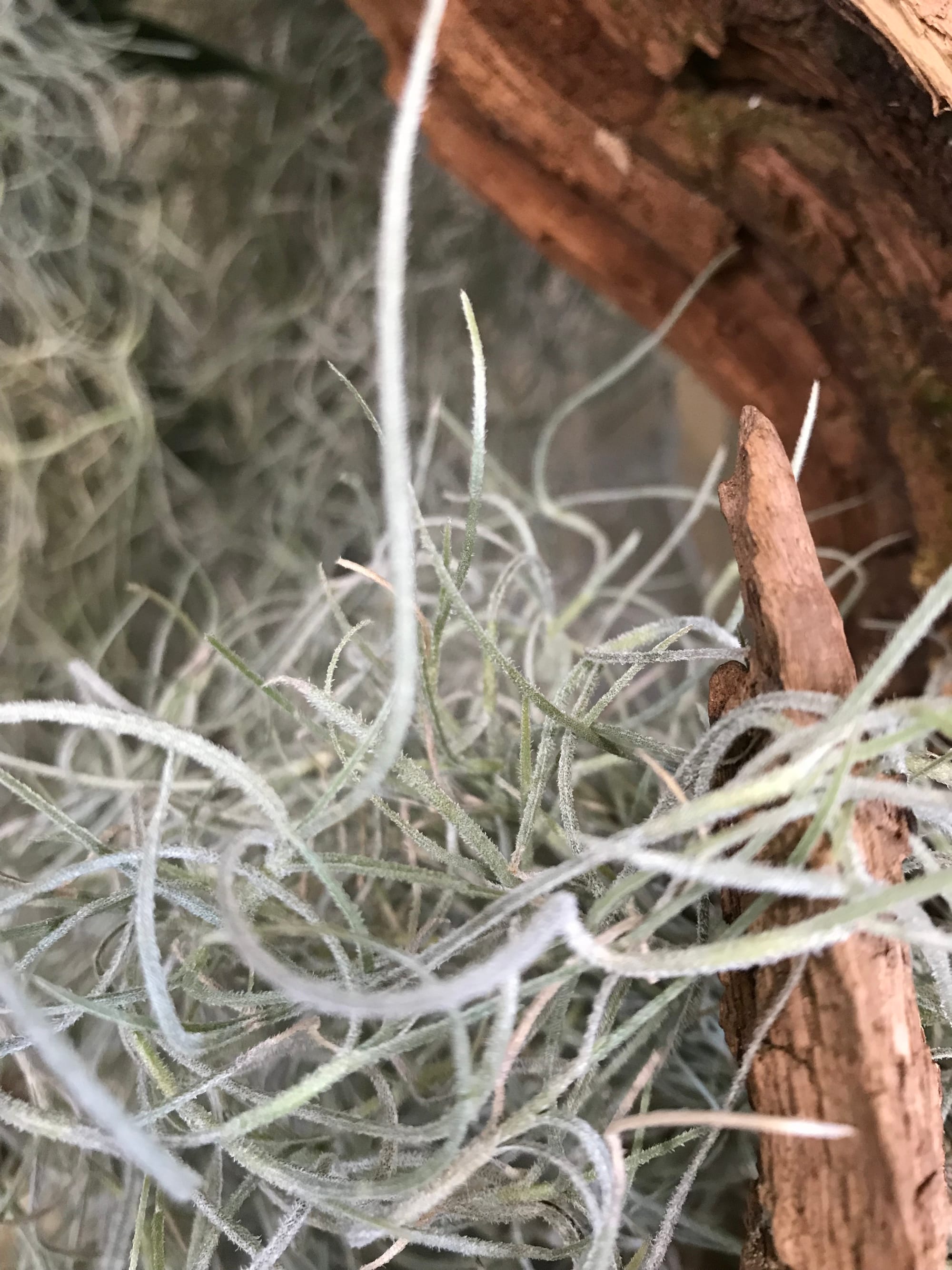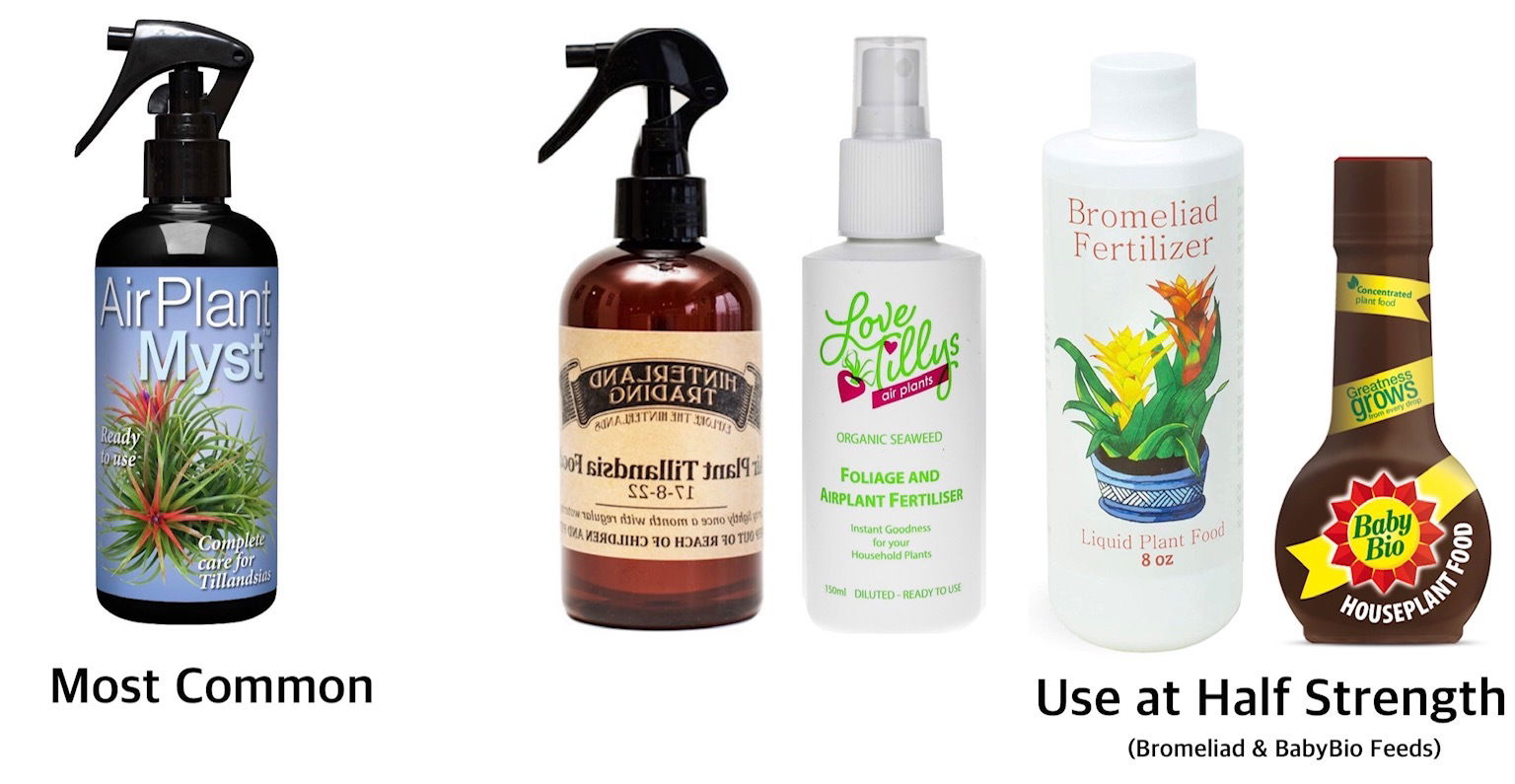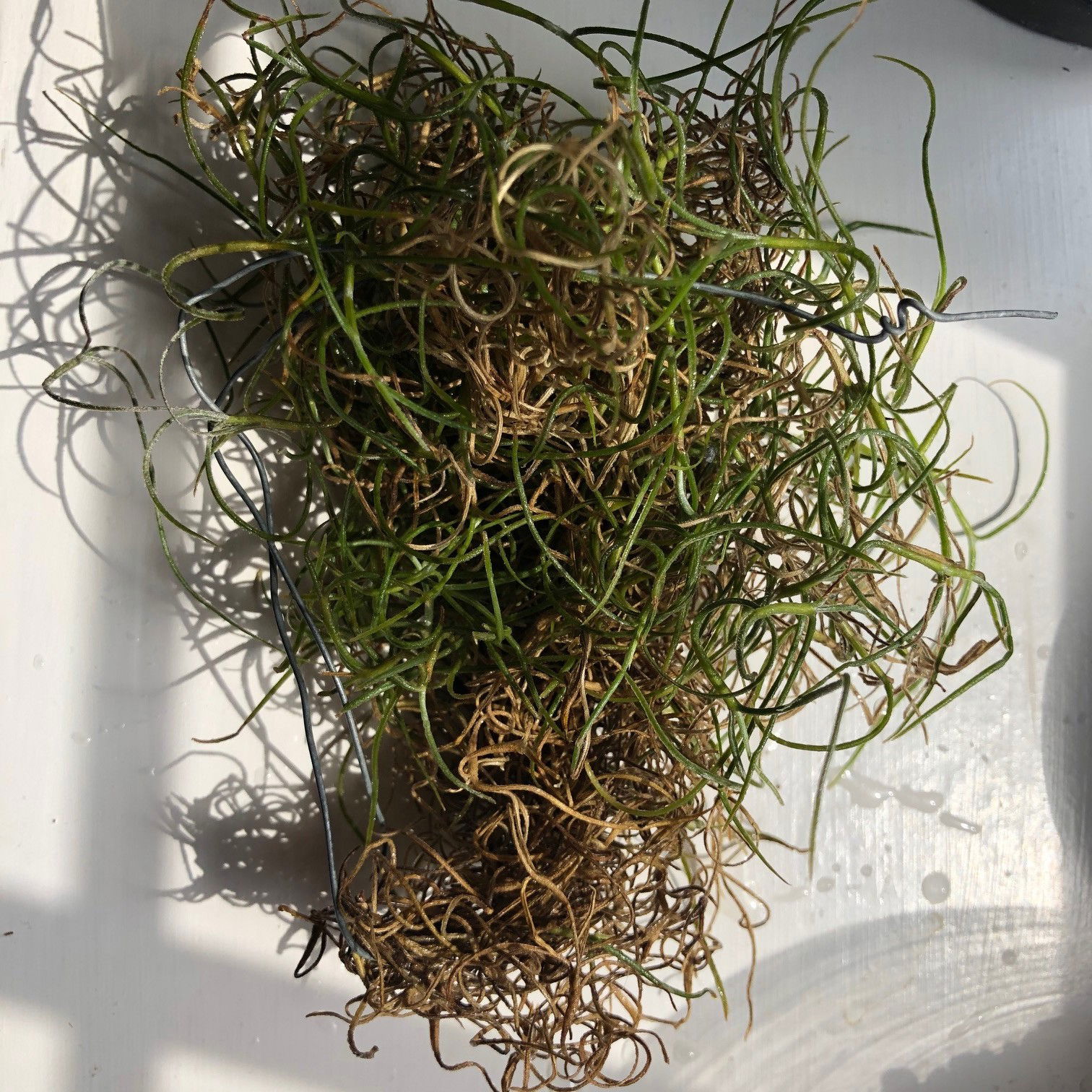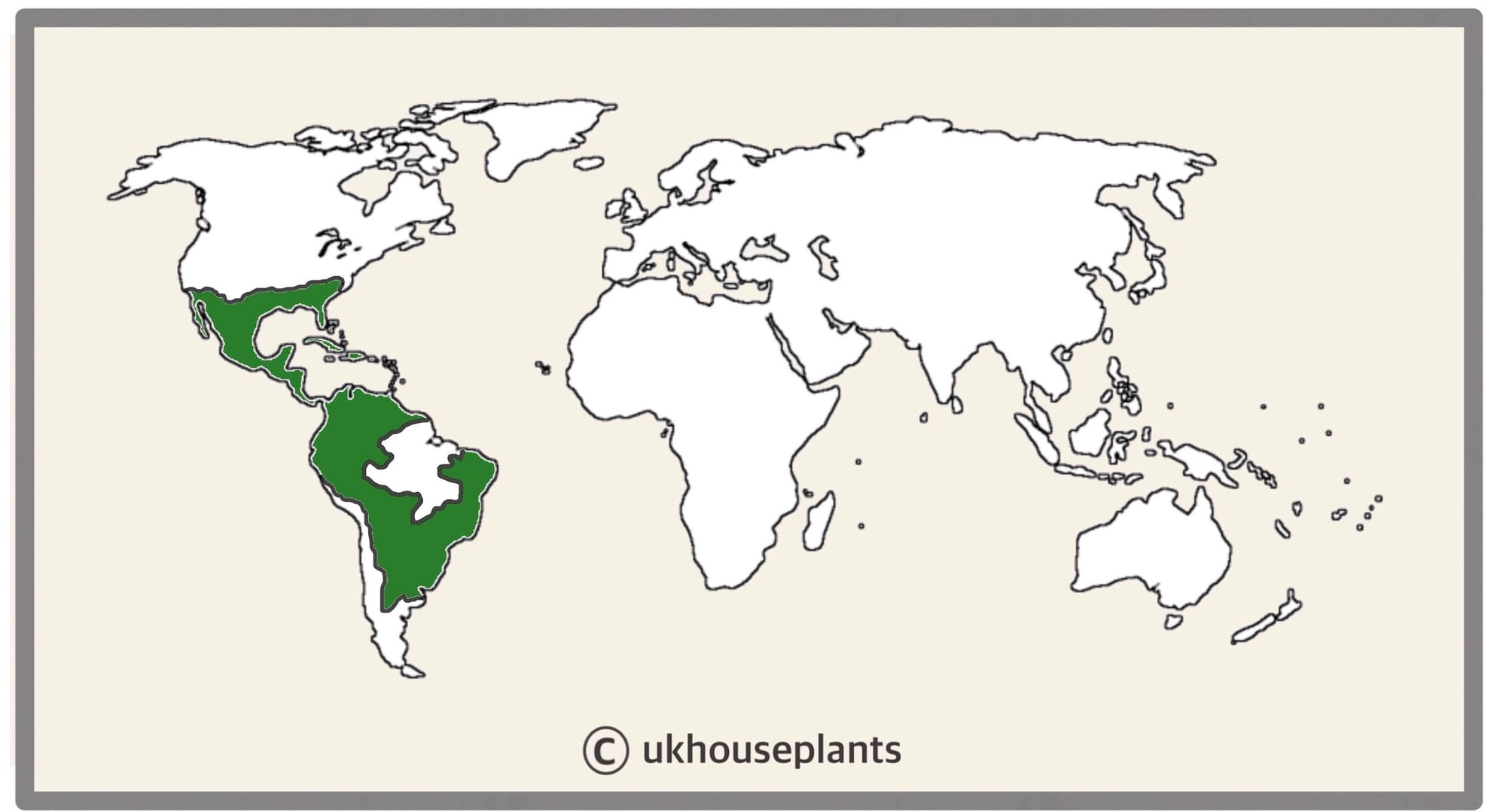
Tillandsia usneoides 'Munro's Filiformis'
Contents
- Top Tips
- Location, Water, Humidity & Fertilisation
- Common Issues
- Origins, Temperature, Propagation & Toxicity.
Need the answer to a specific plant query? Book a 1-to-1 video call with THE HOUSEPLANT DOCTOR™, the website's friendly author, to overcome and address your niggling problem! Available on iMessage, WhatsApp, Facebook Messenger & more.
Top Tips & Info
- Care Difficulty - Easy
- Provide a bright, indirect setting that offers a good view of the sky and avoid locations near working heaters or other heat sources.
- Finely mist the foliage once a week throughout the year. Three days later, submerge the whole plant for an hour at monthly intervals, before reducing this to every ten days in the autumn and winter. Make sure that the plant is shaken and placed on a tissue straight after the submersion to remove the excess moisture that may result in rot.
- In the spring, separate the batch into individual sections if you're interested in doubling the stock.
- Dehydration is a typical problem with Spanish Moss; scroll down to 'Common Issues' for further information on the matter.
Location & Light - 🔸🔸
Spanish Moss are epiphytes, meaning that they grow on trees in the wild and therefore should never be placed in intense direct light. Provide a bright, indirect location that boasts high levels of humidity (bathroom, etc.) with good air circulation. You must avoid dark areas where a newspaper can't be read without the use of artificial lighting as foliage rot is a common issue among damp environments.
Water - 🔸🔸
There are several key ingredients to successfully hydrating Spanish Moss without the risk of over-watering. The frequency in which you'll need to mist and submerge the specimen will solely rely on the light levels and the current season that you're serving. Choose from one of the following watering methods;
1. Finely mist the foliage once a week throughout the year; this will not only downplay potential dry air, but it'll also keep the foliage hydrated until the forthcoming submersion. You can incorporate an 'Air Plant' labelled fertiliser into the mist once every two or four weeks, depending on the current season.
2. Or, submerge the whole in lukewarm water for an hour once a week, reducing this to fortnightly in the autumn and winter months. The foliage must become dry again within two hours as the risk of foliar rot is heightened in excessively moist situations. Situate the specimen on a tissue after a light shake to ensure the moisture is removed. Irrigations must never occur during the night, as the combination of longer drying-out times and low-light will significantly increase the chance of plant death.
Fertilisation - 🔸
Monthly supplements using either 'Bromeliad' or 'Orchid' labelled feed (both at half strength) is best to provide the vital nutrients for Spanish Moss. Go against using a 'Houseplant' labelled fertiliser on this one due to the heightened risk of foliar-burns. Pour half the recommended strength into a non-metal container of water when its time for hydration. There are also 'Air Plant Mists' that will do the job, too; mist the foliage weekly on top of the other hydration-mists to provide the correct nutrients that the plant requires!
 Our recommended feeds for Air Plants.
Our recommended feeds for Air Plants.
Common Issues with Spanish Moss
How Do I Tell If My Spanish Moss Is Dead? To know the overall health of your plant, make sure to submerge it in water for around ten minutes before taking it back out. Look for any browned areas of the Moss and prune them off with a pair of clean scissors. You may need to re-attach the green (alive) sections of the plant back to the metal frame with string or fishing-wire. Have a look at the image below to see the difference in colours between an alive and dead section of the plant.
Brown tips symbolise possible under-watering, or the surrounding humidity is not high enough. During the colder months, heaters will be on full steam ahead, meaning that dry air will be at its highest. Keep an eye out for the development of browning tips on juvenile growth.
Severe under-watering or too much sunlight usually go hand in hand; the sun will dry out the plant much quicker than those in a shaded spot. If the plant is saveable, give it a good two-hour soak and move its habitat into a slightly darker location. Typical symptoms include the yellowing or greying of foliage, stunted growth and crispy tips that'll show themselves during when saturated. Have a look at the image below for visual reference.
 Browned foliage is commonly the result of under-watering and potential dry air. Saturate your specimen for several minutes to see how much of it has succumbed to this issue. Prune off the brown sections with a clean pair of scissors.
Browned foliage is commonly the result of under-watering and potential dry air. Saturate your specimen for several minutes to see how much of it has succumbed to this issue. Prune off the brown sections with a clean pair of scissors.
Origins
Although Tillandsia is mostly epiphytic, there are fifteen species that grow terrestrially and therefore require different care compared to their airborne counterparts. The genus was first penned in 1753 by Carl Linnaeus, honouring Dr E. Tillandz, a Swedish botanist and physician during mid-17th-century. Out of the 650 species of Tillandsia, around 630 are classified as epiphytic and are divided into seven subgenera - Allardtia, Anoplophytum, Diaphoranthema, Phytarrhiza, Pseudalcantarea, Pseudo-Catopsis & Tillandsia.
The name, 'Spanish Moss', has very little to do with the country itself; native Americans dubbed it as 'tree hair', whereas French explorers several centuries later called it 'Spanish beards' to take a dig at their western counterparts. Unfortunately for the Spanish, and despite their combat nickname of 'French Hair' shortly after, it was the original name that stood the test of time. The genus has distributions over both North & South America, several parts in Queensland (Australia) and naturalisation in Hawaii in the early 20th century. Since being discovered in 1762, Spanish Moss has an interesting history for human use; from building insulation to padding down car seats in the 1900s - they even used it as sanitary napkins and diapers at one stage! The species' name, 'Usneoides', is based off its similarities with the lichen genus of 'Usnea', that also grows on tree branches across
 The Distribution of Tillandsia usneoides
The Distribution of Tillandsia usneoides
Temperature
12° - 30°C (54° - 86°F)
H1b (Hardiness Zone 12) - Can be grown outdoors during the summer in a sheltered location with temperatures above 12℃ (54℉), but is recommended to stay indoors. If you decide to bring this plant outdoors, don't allow it to endure any direct sunlight as it may result in sun-scorch and dehydration. Regularly keep an eye out for pests, especially when re-introducing it back indoors.
Spread
Up to 80cm in length and 30cm in width, with maturity being reached within a few years.
Pruning & Maintenance
No pruning is required; however, dividing the festoons (strands) will keep the size to a controlled manner. Remove the yellowed or browned areas (as seen on the second image above) to improve the overall appearance.
Propagation
During the spring or summer, divide the festoons (strands) into several clusters. If possible, choose the healthiest specimens as possible, as diseased or damaged strands could cause the whole section to die. Its care requirements will be mostly similar to its original life; however, be sure to water it slightly more frequently than its parent for dehydration reasons. Never propagate a section that's smaller than three nodes, as the lack of stored energy will ultimately lead to death.
Flowers
The flowers open in succession over of up to four months in spring, typically sporting a florescent yellow appearance across each vine. Each individual flower can last up to three to five days, producing a musky fragrance - similarly to the Cyclamen.
Pests & Diseases
It's very rare to find any pests; however, Aphids could be an issue on the juvenile growth.
Toxicity
Not known to be poisonous when consumed by pets and humans. If large quantities are eaten, it may result in vomiting, nausea and a loss of appetite.
Retail Locations
Blue Diamond, Dobbies, Online Stores.
Book a 1-to-1 Call with THE HOUSEPLANT DOCTOR™
If you need further advice with your houseplants, book an advice call with ukhouseplants' friendly and expert writer today! This can be done via a video or audio call on most apps, including Facebook, FaceTime & Skype. A ten-minute call costs £5.99 (US$7), or £15.99 for thirty minutes. You can ask multiple questions, including queries on plants, pests, terrariums, repotting advice and anything in between. Please consider supporting this service to keep ukhouseplants thriving!